Did you know there’s a way to cut back on your trash and feed your plants at the same time? Once you know how easy it is to make compost, you can reuse food scraps and get rich soil for your plants to thrive in.
To make compost, you need organic matter (e.g., leaves, twigs, kitchen scraps), water, & oxygen. Put your materials in a container or pile. The compost needs adequate oxygen & moisture for microbes to digest the organic matter. In as little as 3 weeks, compost can be ready for the garden.
This process will be simple to upkeep once set up, so hang in there if the beginning seems like a long to-do list at first. To start, let’s talk about what compost entails.
What is compost?
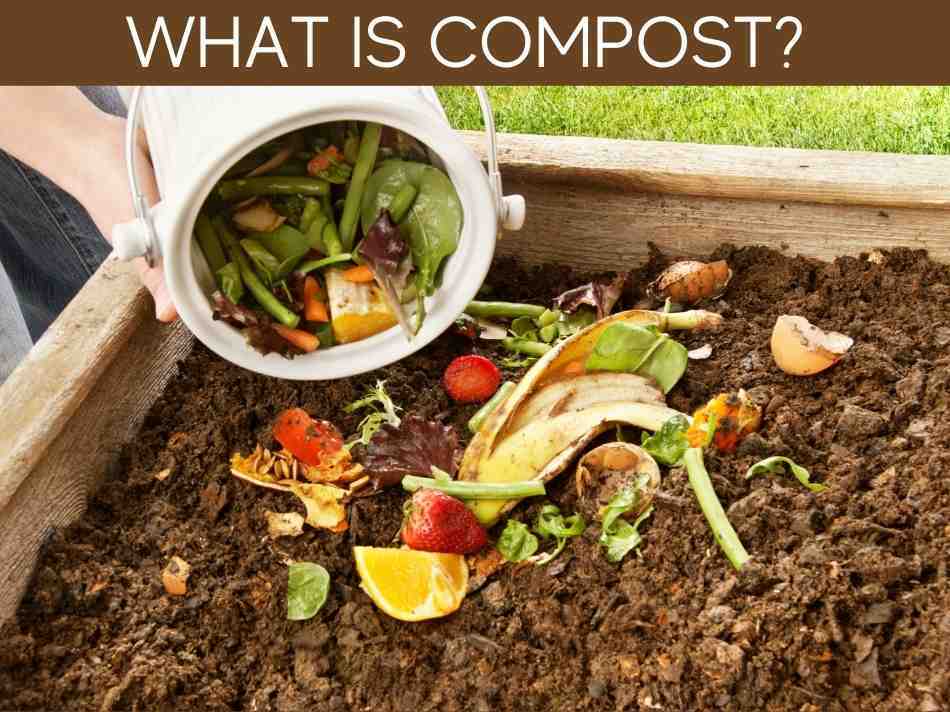
Compost is nothing more than a bunch of organic materials, mixed together, that break down into their components, that you can use to enrich soil.
OK, so that’s a really broad, general, and kinda vague description of what compost is.
Think of it this way:
- You throw a bunch of yard & kitchen waste together
- Some friendly microbes eat it up,
- And you end up with stuff you can add you your garden to jump-start plant growth.
So, it’s actually pretty simple.
And, yes, there’s a bunch of biology & nuance to it, but it really is pretty simple overall.
But to actually create compost, you need to make sure you’ve got all the building blocks to make it work.
So let’s dig into what makes up compost. (Yeah, be prepared for some more bad puns…).
Heat
First, composts need heat. In order to engage the microorganisms that are integral to the decomposing process, the proper temperature of the compost must be maintained. Heat also helps the compost keep out weeds, discourages seeds from growing, and keeps the composting process working quickly.
Heat is actually a byproduct of the decomposition process, so theoretically, if you have the right ingredients, you should be set.
Without heat, the compost will become smelly, and the decomposition process slows down. If your compost starts emitting a smell that you’ve never encountered (and don’t particularly care for) you may need a hotter compost pile.
How do you ensure that the compost is well-heated? We’ll get more into the details soon, but a combination of nitrogen, moisture, bacteria, and volume will help generate the right amount of heat itself.
The optimal temperature range for compost is generally 130 – 150 degrees Fahrenheit.
It is possible to have a “cold” compost, but be prepared for that process to take more than a year. If you’re okay with waiting on your compost pile in order to use it, then you don’t have to worry much about heat.
Microbes
Compost also needs microbes.
You’ve most likely seen macro-organisms around your compost pile: centipedes and earthworms (among many other creepy-crawly critters). Macro-organisms are critters you can see with your naked eyes. You don’t need a microscope to see them.
But unless you’ve busted out a microscope & poked around in your soil or water from a puddle, you probably haven’t seen microorganisms. They’re simply too small to see with the unaided eye.
But you CAN see their work and what they produce–and that’s what we’re after: rich, black, loose compost that’ll enrich our garden.
Compost microbes are bacteria, fungi, and bunches of their friends that help break down the organic materials in the compost pile.
Now, when aerobic bacteria do their job (i.e., eat leaves & other organic matter), they produce heat. That heat–created by the microbes’ metabolism & digestion–is the main heat source for your compost pile.
The microorganisms that you want in your compost decompose more efficiently and effectively at higher temperatures. As long as you let the microorganisms complete their mission and keep pesticides away from your pile, your compost should be set.
Green matter
OK, so far, we have microbes and heat–they go together like peanut butter & jam. Mmm, jam…
But our micro friends need something to eat–otherwise, they can’t produce heat or release the rich nutrients that we want to get into our garden plants.
So what do we feed our microbes?
First, let’s talk about decomposition: that’s what we call when microbes each organic matter, thereby releasing carbon, nitrogen, oxygen, water, and other micronutrients (potassium, phosphorus, etc.) that were bound up in things live leaves, wood, and kitchen food scraps.
Having too many of any of these components isn’t terrible, but it can create an imbalance and slow or halt your compost’s progress.
So, we need to feed our microbes 2 basic types of food: green matter and brown matter.
- Green matter tends to be rich in nitrogen.
- Brown matter tends to be rich in carbon.
Think of green matter this way: probably anything that you might want to compost directly from the cutting board in your kitchen, such as vegetable peelings and fruit scraps. You can also count coffee grounds, tea bags, and (actually green) garden trimmings in this list–grass clippings, hay, weeds, etc.
But something that DEFINITELY shouldn’t be in your kitchen–but which is definitely considered “green” matter for composting–is manure. Yeah, it’s brown all right. But it’s considered “green” for compost because it’s high in nitrogen.
Brown matter
Now that we’ve got a better idea of what “green” entails, let’s move on to its partner that releases carbon.
This list of brown matter contains a mixture of things that you would find inside and outside your house. From the kitchen, eggshells, nutshells, corn cobs, stalks, paper towels, napkins, brown paper bags, newspaper, and dryer lint can be used.
Think of these brown matter as less-edible than the green ones. Kinda like roughage for your compost pile.
Other possibilities lying in your backyard would be dry leaves, hay, and sticks.
While green materials bring in the moisture, brown materials help dry it out.
Keep in mind that both the green and brown materials added need to be in smaller sizes, so try to stick to 1.5 inches in length or less. Overly big materials can slow down the composting process, while smaller sizes speed up composting. For more detail on how to speed up your compost, keep reading–I’ve got an entire section devoted to the science-y method for fast compost.
And if you want to get your hands on some free (or cheap) brown matter, check out our article on how to fill raised beds for cheap.
How much green vs. brown for a compost pile?
If you’re a super nerd, you might want to create a delicate balance between green & brown stuff in your compost pile–to dial in that magic Goldilocks ratio.
But if you’re like most folks, getting the perfect ratio of green vs. brown is only important if you’re trying to make compost FAST.
If you’re a bit more relaxed about things, then the green-to-brown ratio in your compost is less critical.
In general though, the microbes in compost work optimally when there’s a 30-to-1 brown-to-green ratio.
However, that doesn’t mean you should put 30 times as much wood as kitchen scraps in your compost pile. That’s because the optimal ratio is for carbon-to-nitrogen. And the amount of carbon or nitrogen in each thing you feed your compost pile is going to be different.
Here’s a list of common compost materials, and their carbon vs. nitrogen content:
| Materials High in Carbon | C:N ratio |
|---|---|
| autumn leaves | 30-80:1 |
| straw | 40-100:1 |
| wood chips or sawdust | 100-500:1 |
| bark | 100-130:1 |
| mixed paper | 150-200:1 |
| newspaper or corrugated cardboard | 560:1 |
| Materials High in nitrogen | C:N ratio |
|---|---|
| Vegetable scraps | 15-20:1 |
| coffee grounds | 20:1 |
| grass clippings | 15-25:1 |
| manure | 5-25:1 |
| manure | 150-200:1 |
Oh, and if you’re thinking of dumping a truckload of coffee grounds into your garden, take a look at our full article on what the science actually says about using coffee grounds in the garden.
OK, so my head’s starting to hurt from all this complexity.
It’s a compost pile, not a Mars rover.
As long as you make even the feeblest attempt at having more brown than green, your compost microbes should be happy enough.
Besides, they can’t complain.
How does compost work?
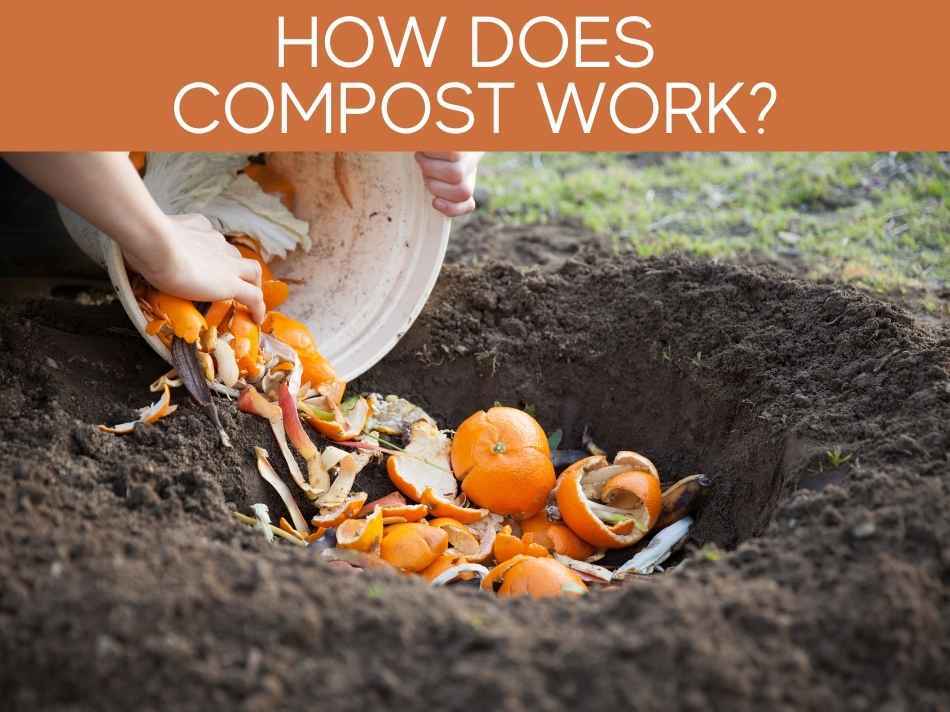
OK, so composting might SEEM like magic. After all, you through a bunch of waste, along with a little soil, and some water into a pile. Then turn it every so often, and BAM! High-quality garden soil.
But it’s not magic–just chemistry & biology.
The basic process of how compost works is this:
- Microorganisms–chiefly bacteria–eat vegetable matter (like leaves, wood chips, or kitchen scraps).
- The microorganisms use oxygen and water to digest the vegetable matter.
- Through their digestion, the microorganisms generate heat.
- After digesting the vegetable matter, the nutrients–nitrogen, phosphorus, potassium, etc.–are transformed into chemical compounds that are easily available for plants.
That said, the biology behind decomposition is actually pretty simple. Decomposition is first and foremost, known as an “aerobic process.” Meaning that the microorganisms at work must have oxygen in order to interact with the organic material in the compost pile.
Through the process, organic materials change from their current form to become “humus” or decomposed soil. Microorganisms receive carbon from the organic materials, giving them energy, and then they produce nitrogen as a byproduct, which in turn breaks down everything in the compost.
What does NOT belong in compost (and why)?
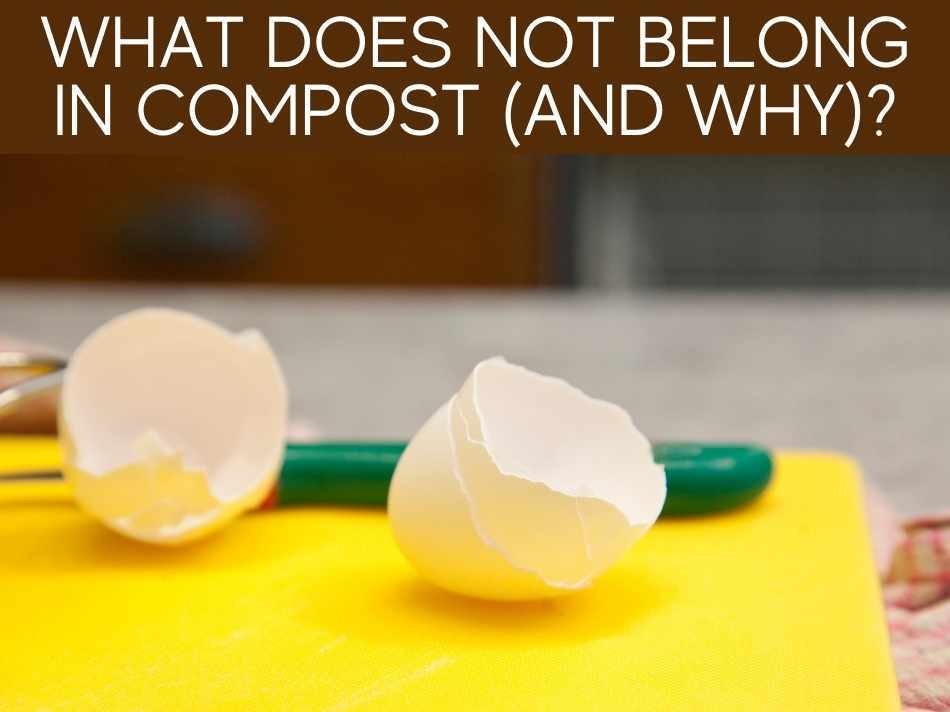
All organic materials decompose, but we want our compost pile to be as efficient as possible.
No animal products in compost
Because of this, products such as meat, fish, or egg scraps should not be put into a compost pile. This also includes any dairy products, animal fat, or grease.
That’s because animal products take a long time to decompose and require high-heat to kill harmful microorganisms.
Again, while it is possible, for the purposes of your compost pile, you may want to consider sticking to the greens and browns listed above.
These materials also present odor and pest problems. While green materials such as an orange peel may attract flies and worms (good for decomposing), meat scraps will attract rats and other animals to your compost pile.
You’re trying to create good soil for your plants, so why would you want raccoons rooting through it before it’s ready?
Other things to NOT include in compost
Since nutrient-rich soil is your goal, a few other no-no’s are worth mentioning:
- Any plants with pesticides, or the opposite, that have been exposed and eaten by pests pose harmful to your soil as they may carry germs, parasites, or chemicals. Coal or charcoal ash is detrimental to plants, so this is not an option either. This is pretty self-explanatory, but be sure to check before adding anything to your pile.
- Even though manure was mentioned under green materials, please be aware that this does not include feces from your domestic pets. To be clear, the manure that can be used is specifically from a herbivore and not a meat-eater (such as a dog). Unfortunately, meat-eater waste cannot be trusted to be free of parasites and should therefore be avoided.
Overall, if you have any doubts, check this list. You will not want to undo any progress that you’ve made simply because you didn’t spend time checking on the benefits or disadvantages of putting a certain material into your compost.
Compost requirements
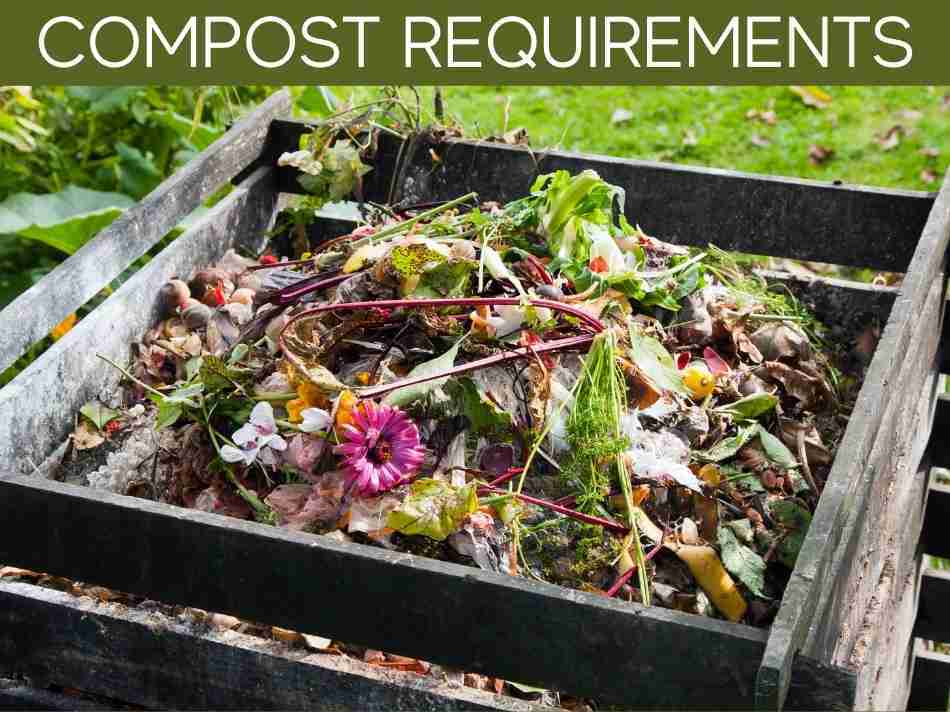
We’ve got all the materials, but what is actually required in order for all of these materials to work together in order to decompose?
Do you just add them all together and wait?
Temperature between 130-160F
We mentioned this earlier, but temperature is very significant. Heat within your compost pile is essential, so be aware of your compost’s surroundings; make sure that there is enough protection from the elements. That way, your compost pile will stay hot enough to kill harmful bacteria–between 130-160 Fahrenheit.
You can do this by putting your compost in the shade, in sunlight, in an area protected from wind and rain, or any place that will guarantee a somewhat stable environment. A tarp over your compost pile can also do the trick.
Moist, but not too dry or too wet
A dry compost pile spells trouble – your compost needs water and moisture in order to actively decompose.
In general, your compost should feel like a damp–but not dripping–sponge. It’s possible to have compost with too much moisture, so be cautious.
If your compost has become too dry, you can pour some water on it and toss it to make sure that the water is reaching all parts of the pile. You can also put your water hose in the middle of the pile with a small stream coming out – just be sure to monitor just how much water your pile is receiving.
If your compost is too wet, then it is time to add some dry materials. Items such as straw and hay can take care of the excess water. When your compost becomes slimy and swampy, then that’s the sign of too much water.
Oxygen
Finally, oxygen is required for your compost to perform and produce good-quality soil. Clearly, your compost pile should have access to air, but there are other ways to ensure that your compost pile is receiving the right amount of aeration to decompose.
If you’ve got your compost in a container, be sure to have ventilation set up in order for the microbes to utilize the oxygen in the air.
You also need to “turn” the pile often. By mixing the pile, you will allow all parts of the compost to have access to the air it needs, even if it’s momentarily. A slimy and heavy pile may also signal the need for some aeration-action.
How to Speed Up Compost
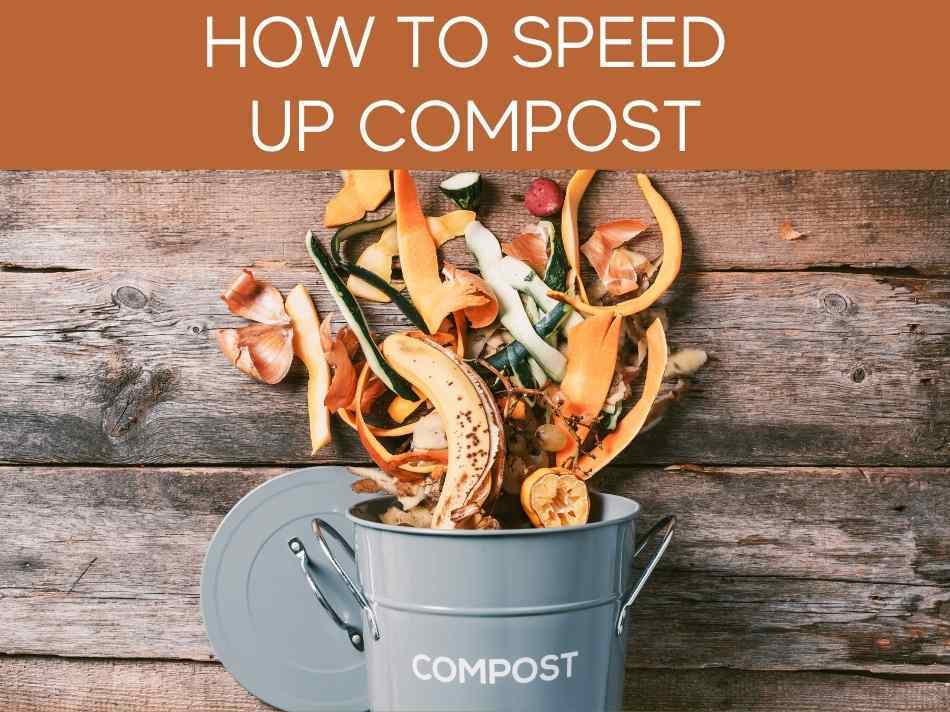
Now that you know how composting works, it may surprise you to learn that you can actually speed up the process.
Even though you’re relying on microbes to do the work for you, you can actually make the right environment for the most efficient decomposition.
Yep, by optimizing things, you can make compost–from kitchen scraps to ready-to-use soil–in about 2-3 weeks. Yes, you read that right: just 2-3 weeks.
Preparation
In order to make the decomposition easier and faster, you can actually reduce the amount that needs to be decomposed by shredding or chopping up your green and brown materials.
If compostable items & pieces are bigger, such as sticks or limbs, then you can help the process speed up by breaking these materials down into much smaller pieces.
So, the smaller the pieces to be composted, the faster you’ll get ready-to-use compost.
This is really the key: Small pieces = fast compost.
Include Both Green & Brown Materials
Like I mentioned earlier, it’s crucial to have a mix of both greens and browns.
Having only one or the other reduces your chances of having a working compost.
It’s best to have a ratio of 2:1 (green to brown) in order to guarantee a more efficient compost. Green and brown materials work together to provide the nutrients that microbes need, but they can become unbalanced if the amounts provided aren’t carefully added.
Compost Pile Size
It generally doesn’t matter how big your pile is, but keep in mind that whatever pile size you have now, it will shrink down. If you’re looking for a quick compost, you will not want to reduce your pile size, as it will not produce enough heat to decompose. Keep your piles bigger in order to go faster.
Watering a compost pile: why & how much?
Moisture is an incredibly key factor in decomposition. You’ll want to maintain the moisture level each day, as letting it get too dry or keeping it too wet will slow down the process tremendously.
Have a hose or pile of hay nearby to help push the compost in the right direction.
Compost Aeration: why & how often?
Since decomposition relies on air to actually move forward, you’ll want to make sure that it is receiving enough oxygen or has access to air. In order to do this, you will have to turn the pile frequently to allow enough air to impact all parts of the compost.
What makes compost?
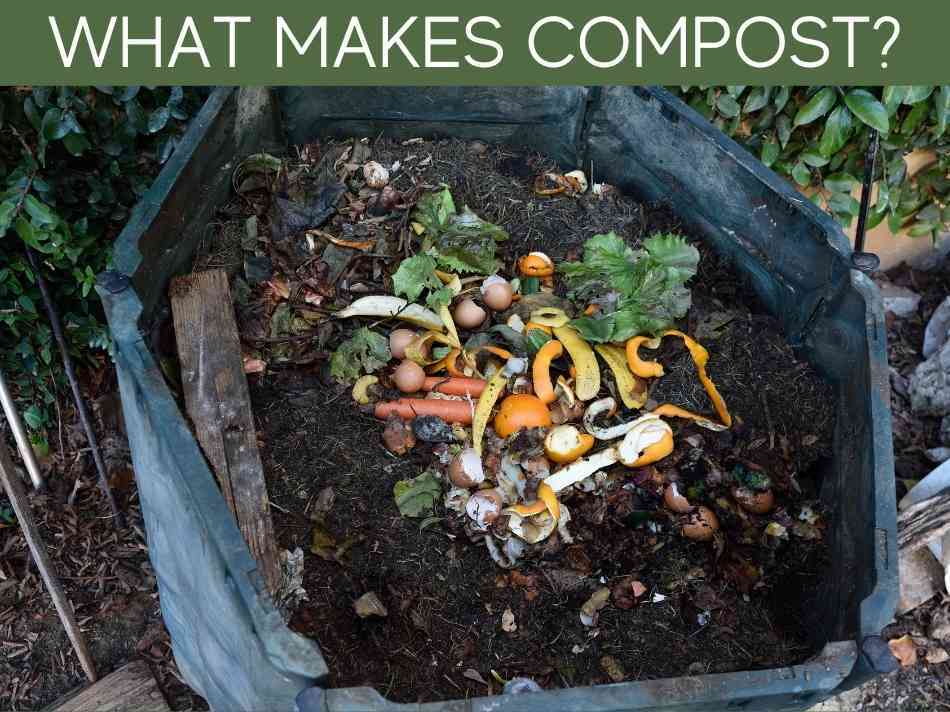
To be clear, you’ll be creating compost with some required ingredients and then continue adding various materials in order to keep it going.
Your basic ingredients include green (nitrogen) materials and brown (carbon) materials. You’ll need a balance of the green and brown parts of your pile, as the compost must get enough of both in order to do its job correctly.
Basic Necessities to build compost
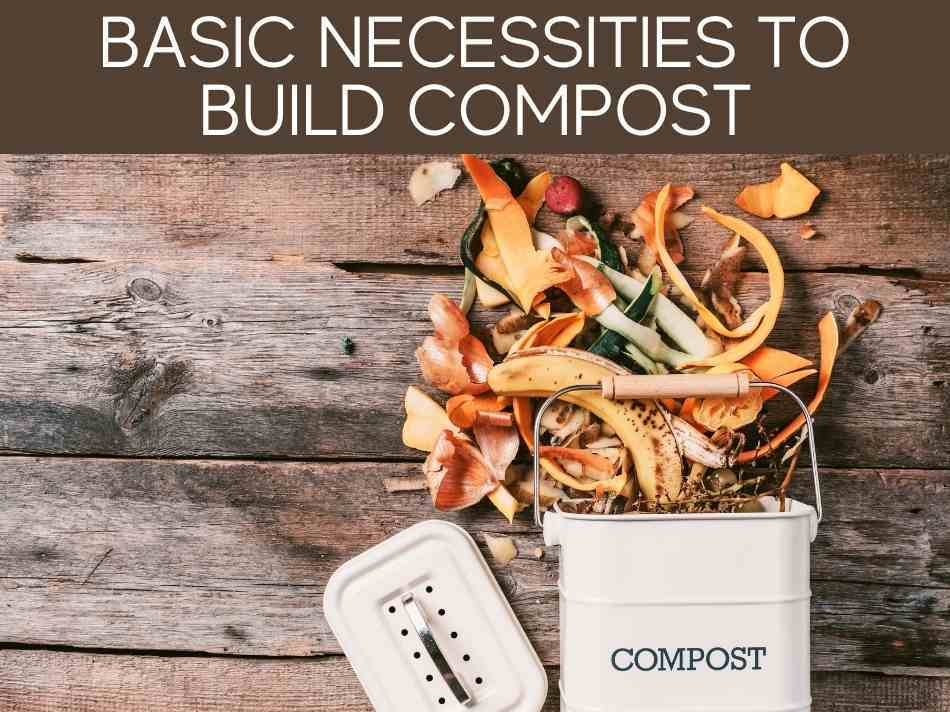
To put together a compost pile, you’ll need a few basic things.
Compost container or area
You’ll need to have a container of some sort in order to hold everything in place, such as a bin, tumbler, or an open pile within some barriers.
For people wanting to have their compost inside on their kitchen counter, a tumbler may work best.
Since most people use composts as a way to create soil for their plants, you may also want to consider putting your compost outside, if possible, and close to your garden.
Green & brown matter
As mentioned above, you will need a good balance of green and brown materials. These things may or may not actually be the color green or brown, so be aware of what qualifies as each.
For example, fruit, vegetables, and manure are all “green” materials because they produce nitrogen. Straw, dead leaves, and branches are “brown” materials because they produce carbon.
If you’re unsure about whether something is considered a green or brown material, don’t hesitate to consult the internet about it! You are not the first person to wonder, and you won’t be the last.
Oxygen
Additionally, your compost will need access to air. This sounds like a no-brainer, but there is a bit of work included within it.
Since your compost will have layers, each layer will need access to air; this is where you come in. Turning the pile occasionally will provide access to all parts of the compost access to the oxygen it needs in order to break down the organic materials.
Water
Finally, your compost needs to be watered and remain moist. In order for the compost to initiate and maintain its decomposition process, access to water is necessary. However, too much water can upset the balance, so make sure to have a way for excess water to drain out.
Ideally, this should be all you need in order to gather all of the components to begin your compost pile. As far as more specific details on materials, upkeep, and maintenance, keep reading! There is definitely still more important information to cover.
Where can I put compost?
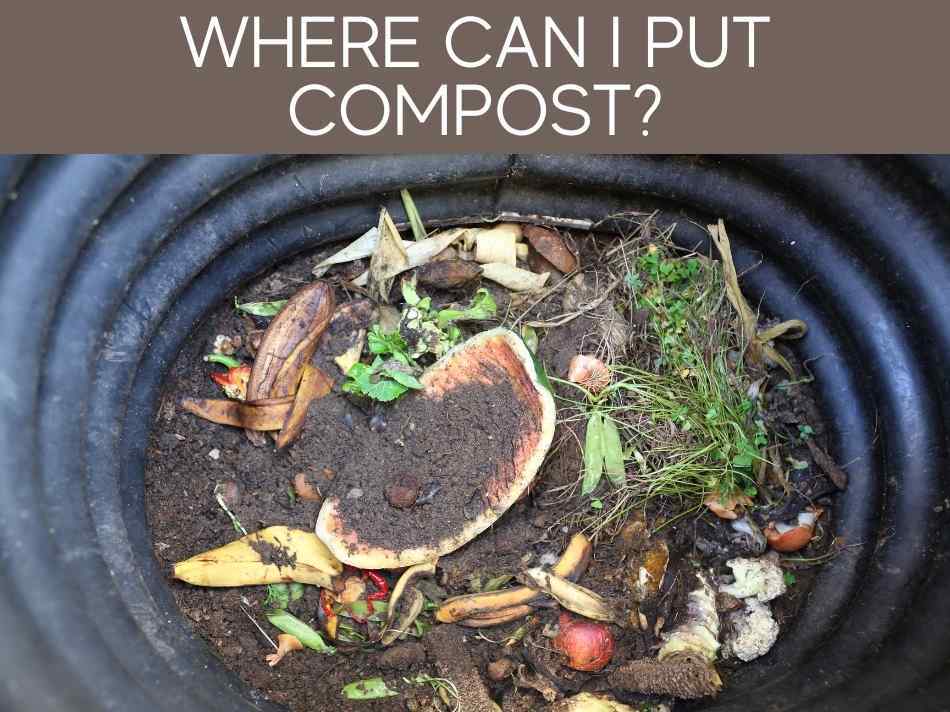
Now that you know what belongs and what does not belong in compost, let’s move on to the location of it.
Maybe you’re wondering if you can compost food scraps in your apartment–even if you don’t have access to a backyard or big area for it.
For urban settings, tumblers and bins work best. You need to make sure that you have access to brown materials as well, however.
Tumblers
This can consist of a small container specifically for composting (you can find them on Amazon) or something that looks like a cookie jar. You are most likely wanting to be able to compost without it taking up much room or standing out in your kitchen, so a tumbler might be your best option. You can keep this container on your kitchen counter next to the sink, or even under the sink in order to keep your counters looking clean.
Wherever you decide to place your compost, be sure that there is still access to air. Remembering that you have a compost tumbler is also important, so keeping it out may be best for the first couple of weeks in order to remind yourself of this new option.
Bins
This option is a little bit larger but still manageable in an apartment or small house. Anything that can hold a bit more than a tumbler, such as a trash can, wooden box, or file organizer would work! A cardboard box would not be best, simply because the compost would decompose it as well as the other organic materials.
In some cases, a barrel-like bin with an opening on the top would also work. The circular shape will actually make it easier for you to mix the compost regularly.
As far as where the compost bin should live, it should probably be near the kitchen or on the back porch. Place it where you can easily access it and direct others to use it as well.
Open-pile
If you’ve got a backyard or space for an actual pile of compost, great!
You can simply set up a specified area of composting with fencing and boundaries to hold it in.
Since this option is not as easy to pick up and bring to a water source, make sure that you’ve picked a place that a water hose can reach.
If possible, it’s beneficial to create three compost piles, so that you have “one ready to use, one being tilled, and one being filled up”.
Upkeep and Time Commitment
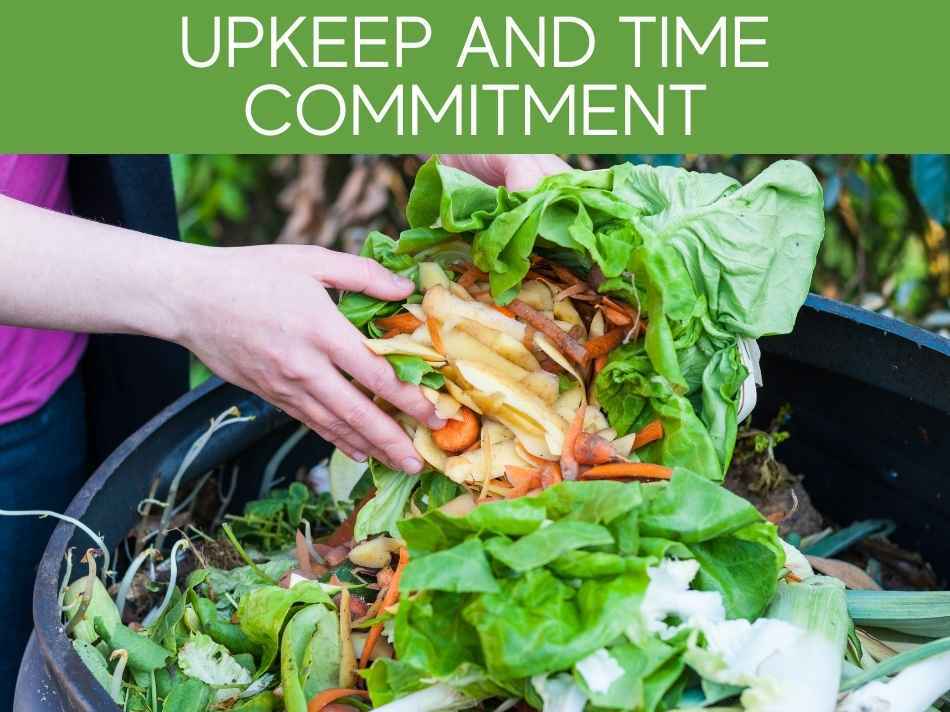
Once you’ve got your compost going, there is not a whole lot of upkeep involved.
But in order to create a productive compost pile, there are a couple of things that you have to do.
Begin with Layering
We want the more sturdy brown material to be the structure of our compost, so start the pile with twigs, branches, and dry leaves. Next, add a layer of green material, such as vegetable trimmings or other scraps, but save some for another layer later.
In the middle layers should be more green materials, such as lawn clippings, fresh leaves, and manure. Stack some more green material kitchen wastes next, with more green leaves following that. Lastly, finish the pile off with the final layer of sawdust, if you have some.
This is the most ideal order of layering, simply because it sets up the decomposition process to run as smoothly as possible. If you find that your compost is not working at the fastest rate, you can experiment with the layering to see if another order works better.
It should take around 2 months for your compost to fully decompose its organic materials and be ready to be used as soil.
Collecting Scraps Regularly
Of course, in order to keep your compost going, you will need to make sure that you are maintaining the routine to keep adding in green and brown materials. Whether you are doing this for richer soil or to recycle waste, it is important that you don’t forget to organize your trash.
Mixing and Turning
Remember how we talked about compost needing air? This is the part where you need to physically help ensure that your organic materials are getting the oxygen they need. In order for air to get in, you need to mix or roll the layers around so that air can be let in on all sides. This is pretty essential, so don’t forget this part!
Compost Log
No, I’m not talking about a wooden log. But rather a journal or timeline of what you’ve done.
Some people find that creating a digital or purchasing a physical notebook to help you remember when you added layers or last turned the pile. Depending on what works best for you, you can order this by dates and leave notes on how the decomposition process seems to be going, what the smell was, whether the pile is breaking down, or if the pile is damp, moist, or warm.
Essentially, keeping a record of your observations will help you figure out what went wrong (or right!) and what needs to be fixed.
The more information that you can gather and remember about your compost will help you improve your routine the next time you build one.
Benefits of Composting
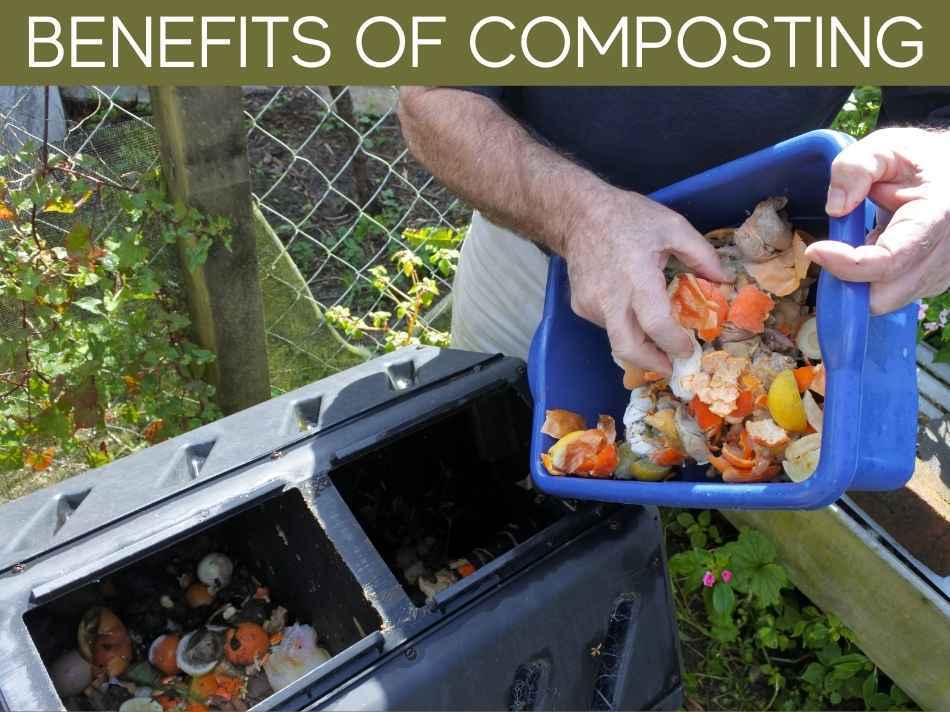
You may already have some ideas as to why you want to start a compost pile for your place of residence, but here is a list of reasons why composting is a good idea.
Reduces Waste
Landfills end up taking far more than they should; if more people had composts, then there would be less waste of perfectly good organic materials to break down.
Instead of creating methane emissions sitting in a landfill, your scraps are now contributing to your compost and helping create new, usable soil.
Creates Organic Fertilizing
Instead of having to go out and buy soil, you can make your own! Store-bought fertilizers can’t always be trusted to be without chemicals, so by making your own, you are ensuring that your soil is as organic as possible, which will be better for your plants.
Low Cost
It really doesn’t cost very much to start and keep your compost going. If you don’t have certain materials at your disposal, then you may have to go purchase them, but most composting materials are incredibly inexpensive. As for the scraps from your kitchen, you were going to throw them away anyway, so it is definitely affordable.
Troubleshooting common compost problems
If you follow best practices, composting is pretty simple & hands-off.
But if you run into problems, the most common compost problems, causes, & fixes are the following:
| Problem | cause | Solution |
|---|---|---|
|
Compost not breaking down |
|
|
|
rotten or ammonia odor |
|
|
|
flies, fruit flies |
exposed food scraps |
bury food waste under a layer of brown materials |
|
rodents & raccoons |
meat or fatty foods in pile |
|
Related Questions
How can I make compost at home fast?
Collect green materials (vegetable scraps, fruit trimmings, etc.) and brown materials (paper napkins, dry leaves, etc.). Layer them by putting some of the brown materials down as the first layer, the green materials down as the middle layer, and then top it off with some more brown materials. Remember to mix occasionally. The smaller the pieces, the faster the composting.
How long does it take to make compost?
Putting together compost does not take long, especially if you have the materials ready. However, you do have to wait for the decomposition process to make some progress before the compost is ready to be used. Compost generally takes a few months. However, by chopping materials into smaller pieces, you can make compost in as little as 2-3 weeks.
What can you put in your compost bin?
Carbon-rich and nitrogen-rich materials. This includes fresh and dead leaves, branches, sticks, grass clippings, manure, sawdust, eggshells, and fruit/vegetable scraps. Make sure to keep a good balance of each material, however.
